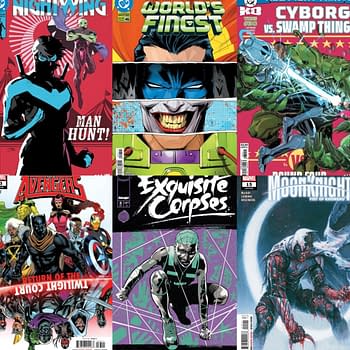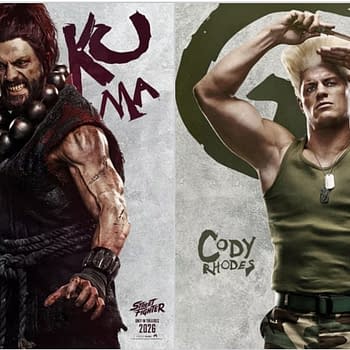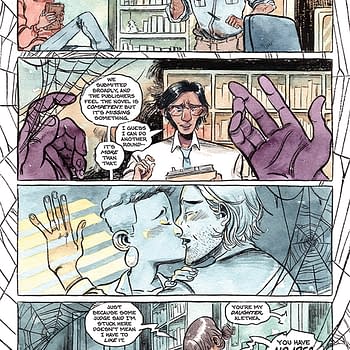Posted in: Comics | Tagged: avatar, Comics, george rr martin, Skin Trade
George R. R. Martin Confirms He's Always Had A Thing For Wolves In Skin Trade
The Avatar Press comic Skin Trade is an adaptation of George R. R. Martin's 1989 Fantasy Award-winning novella by the same name, and one that he's been involved in discussing and promoting rather than taking a more remote stance. Maybe that's because Martin is a lifelong comics fan, but it's also because he's very engaged with his readers in both prose and comic mediums. That kind of enthusiasm and discussion doesn't go unnoticed by readers and is simply the icing on the cake of Martin's already gripping and masterful storytelling. Avatar Press owns Bleeding Cool, by the way, so I actually had to ask to review the comic without creating too much of an echo effect on the site, but given that I was waiting for this comic's release with interest before I started contributing to Bleeding Cool, I made my case for approaching this comic as a fan and a reader. Celebrating good comics is simply an end in itself.

There are elements that readers might hope to find in a Martin story, based on their reading of his prose works or other comics, and I am happy to report that I find quite a few of those Martinesque features in Skin Trade, satisfying my personal fandom. They are: characters with intricate backstories that are only partially revealed, fairly gruesome family dynamics, and an almost obsessive development of geography as setting. Then there's also the more than smattering of gore, which you also might expect from a Martin story. All present and accounted for in Skin Trade, and yet this is a Werewolf story of a unique variety. Wolves seem to be an interest of Martin's, so it's a kind of boutique experience to see him delving into the subject matter so deeply and getting under the surface of such a rich mythology to make it his own.
Backstory is king when it comes to character-building. Doing that without vast amounts of exposition is difficult, but an absolute necessity in comics. Between Martin's story and Abraham's adaptive work, central characters like William Flambeaux, an overdue payment collector, and Randi Wade, private investigator, become increasingly fleshed out for the reader with only a limited use of flashbacks. In some ways, Flambeaux continues to remain the most mysterious character in the comic, and that's saying something considering some of his bizarre colleagues, but that only adds to the story. Where would Werewolf mythology be with full disclosures up front? It's like filmmaking that reveals too much about Werewolf transformation in initial scenes and comes off as hackneyed. Gradual revelations are part of the flavor of Skin Trade. For each bit of new information you receive about characters, such as why Wade takes such an interest in the grisly murders related to animal attacks, the story unfolds several more questions for you. It's exasperating in its own way, but keeps you hot on the trail of information and proves that you're interested in these people and their lives. Having a fairly large cast of characters, by the way, is also something you might expect from Martin, and it's an excellent way to make Skin Trade feel like a story with big implications as many lives are drawn into the developing drama.
Messed up family dynamics, with family ties that seem nearly unbreakable, are also a feature of Skin Trade. Firstly, there are the unusual adoptive relationships that William Flambeaux seems to form with young women who he advises to work their way out of debt. The exact nature of those relationships are still being gradually exposed in the comic, and no doubt there will be more to come. This extends to our central character Randi Wade, who seems also to be one of his protégés, which creates an odd pack dynamic centering around Flambeaux. That means potential for emotion and conflict, and we get that in spades in Skin Trade. Then there's the troubled family history that Wade continues to confront focused on the death of her father by animal attack while serving as a police officer. The lack of resolution over his death continues to plague her, and keep family ties in the forefront of her mind.
But the more overtly messed up dynamics begin to emerge as we meet the town's sinister patriarch, Jonathan Harmon, and his son Steven, who seems to be a kind of contained psychopath held in check by his father's power. There will definitely be more on that front in forthcoming issues, reminding us that in Martin stories families motivate people to nearly heroic acts, but also fester alarmingly under poisonous conditions.
The geography in Skin Trade is one of the most pervasively memorable elements in the story. You start thinking of the down-at-the-heel industry town set among hilly forests as a real place fairly quickly, and that's down to the different locations used and referred to by characters. There are disparate elements within the geography of the story, from an old Brewery where Flambeaux chooses to live, to newspaper offices, bad neighborhoods, and perhaps most evocatively, Blackstone, the Harmon Estate that looms in Hearst-like gothic arrogance above the town. Martin injects details that encourage locations to become far more than reference points in the mind of the reader. The brewery has a cracked mirror in the ladies bathroom, for instance, and Blackstone has its own funicular railway that impresses self-effacing respect on the lowly citizens who approach the mansion from below. Skin Trade is a comic with an impressive sense of location, and that contributes greatly to mood. An obvious comparison, but one that holds up, is to Twin Peaks where a remote, eccentric town can become the locus of haunting mysteries. And of course, it's the perfect setting for a private investigator to investigate her own identity and prise clues out of the unwilling inhabitants of the town. But like in Twin Peaks, it's the woods that really hold the potential for nightmare, and issue two of Skin Trade hints that there's more to come from woodland settings.
What is it with George R. R. Martin and wolves? It's hard to pin down, but Skin Trade may offer even greater insights into this phenomenon, and especially will do so in visual terms. It's clear that there are bad wolves and good wolves in the series so far, and there may even be monsters, but that human beings have a lot more to do with depravity than simple animal instincts for violence. Wolves seem to offer us a window onto the secret life of humans as much as into a secret world of concealed dual identities. To be meta about it, the whole "skin" theme seems to be developing in the comic into a metaphor for skirting the surface of things versus getting to the heart of the matter. Surfaces can change in Skin Trade, but if you ever want to get to the truth, like Randi Wade, it might involve some gruesome exploration.
Skin Trade is shaping up nicely, with an episodic feel that delivers, and it certainly provides plenty of intricacy in storytelling and artwork to keep your attention. Maddening accumulation in questions raised is all part of the structure of a Werewolf mystery story, apparently, and George R. R. Martin certainly knows how to tell this kind of story.
Hannah Means-Shannon is a regular contributor at Bleeding Cool, writes and blogs about comics for TRIP CITY and Sequart.org, and is currently working on books about Neil Gaiman and Alan Moore for Sequart. She is @hannahmenzies on Twitter and hannahmenziesblog on WordPress. Find her bio here.



















